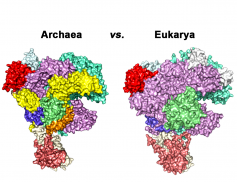
2009/05/07
PLoS BIOLOGY publishes new work from a team of researchers led by Dr. Abrescia, investigating the RNA polymerase from Sulfolobus shibatae using X-ray crystallography.
Acid-loving Archaeon Reads DNA with Enzyme Strikingly Similar to Our Own.
Some extremophilic Archaea organisms read their DNA using enzymes surprisingly similar to our own, providing insight into the way in which the information stored in DNA is unlocked. In this week's issue of PLoS Biology, research by Dr. Nicola Abrescia and colleagues has shown that the enzyme that converts DNA into RNA is conserved between simple single cell microorganisms called Sulfolobus and more complicated 'higher' organisms, including human beings, despite a staggering 2 billion year evolutionary gulf. The paper explores how evolution has shaped our enzyme to accomplish more complex functions.See a large version of the first picture





